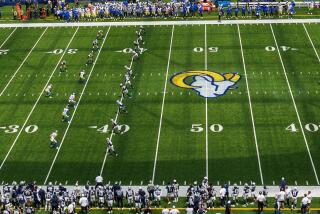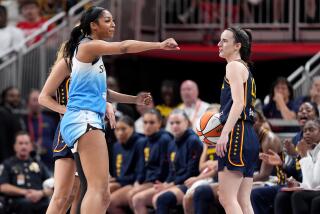Instant Replay Stirs Up More Issues for Fans Than It Settles
It has taken a long time to reach this thoughtful conclusion, but we just about agree with a philosophy advanced years ago by Fred Dryer, distinguished thespian, who used to play defensive end for the football Giants and Rams.
Fred hated instant replay, insisted that it had no place in football. His reasoning:
“They don’t use instant replay at plants where they kill turkeys. It has no place on a football field.”
Instant replay, he said, also causes arguments because, when this technological instrument is employed, a game never ends. The tape is played forever.
Watching the NFL playoffs over the weekend, you saw the Philadelphia-Washington game doubtless decided by instant replay.
The score is 7-6 Washington. A Washington receiver fumbles on Philadelphia’s 6-yard-line. A Philly guy picks up the ball and runs the distance--94 yards. Presumably, this put Philly in front, 13-7, and turns the game in a way that might have been the end for Washington.
But the picture crew overrules the field crew, deciding that the fumble occurred when the ballcarrier hit the ground.
It is such a close call and so vitally important to the outcome that a lot of people looking at the replay get mad. Countless times, reviewing tape, they have seen similar plays ruled the opposite.
That’s the problem with football today. Without tape, we would be happier in our ignorance.
In the playoff game between Kansas City and Miami, Kansas City in the closing minute is moving into field-goal range to overtake Miami, leading 17-16.
The Kansas City guy runs to the Miami 15, but holding is called on Kansas City, reversing it to its 38, or too far away for its field-goal kicker.
Instant replay reveals possible holding by Kansas City, but time after time after time, instant replay reveals holding that isn’t called.
What the camera is doing to football is dramatizing the inconsistencies. It causes unhappiness, if not depression.
Is there consistency on the part of officials in the calling of interference?
On a marginal interference call, they award the Raiders 45 yards in a recent game with San Diego. It leads to a Raider score. They eventually win, 17-12.
If, on pictures, viewers didn’t see other cases of interference, not called, they would have no grounds for grievance.
Is there consistency in the calling of in-the-grasp, that judgment involving tackler and quarterback?
How consistent is the ruling on late hits? Sometimes, they call, sometimes, they don’t.
Do you know football’s greatest inconsistency? It is the simple spotting of the ball. Where does so-called forward progress end?
Well, the referee will rule it ends at one particular place, a foot short of a first down, and the pictures will indicate that the team with the ball has been jobbed.
The original judgment is irreversible. The viewer hollers foul, but he may as well appeal death.
The peace of those watching football on TV today is shattered further by analysts who make a point of using pictures to harp on officials’ errors. When the NFL controlled football telecasts, this wasn’t allowed. Announcers were heard to say: “Those men in stripes are doing a great job.”
But what they say about the men in stripes today is their own business. And seizing upon the pictures, they harp on calls, stirring the masses.
We don’t like to row into the tide of science, Instant replay is an advancement, widening our knowledge. But it isn’t good for mental health. It also raises blood pressure and cause backaches and recurring migraines.
The football fan was happier when he was dumb.
More to Read
Go beyond the scoreboard
Get the latest on L.A.'s teams in the daily Sports Report newsletter.
You may occasionally receive promotional content from the Los Angeles Times.










